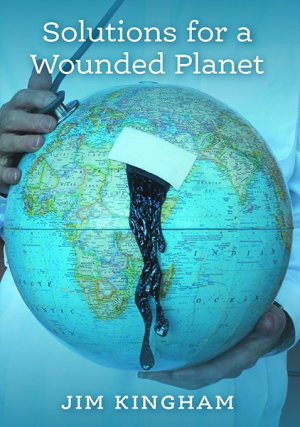
Solutions for a Wounded Planet
Solutions for a Wounded Planet is an ecology book that suggests a global, holistic approach to saving the planet for future generations.
As an unsettling and eye-opening assessment of environmental problems, Jim Kingham’s ecology book Solutions for a Wounded Planet calls for urgent action.
Across its three parts, this book discusses human impacts on the air, water, land, and other species; covers necessities that are prioritized for human survival, including food and shelter; and identifies specific steps for healing the environment on personal, family, and community levels. These assessments name grim realities, but their intention is still to impart hope—even as they chronicle missteps that resulted in environmental damage.
The book makes strong use of declarative statements to drive itself forward. It calls upon its audience to stop the profit-driven consumption and destruction of finite resources, and it discusses climate change in an unvarnished manner. Unflinching rhetorical questions intensify its probing tone, addressing human decisions to dump more garbage on shrinking personal plots, and expressing bewilderment about how people landed in the climate mess in the first place. The book is bold in tackling disturbing messages about widespread destruction as conveyed in pop culture, too; in such moments, it worries aloud that younger generations may have a diminishing interest in caring for the planet.
The text provides undeniable evidence about the need to reduce air pollution, as well as about changes in global temperatures over the years. It covers carbon emissions by country to further its discussions of pollution problems, and it reveals that energy production and use have doubled in the last fifty years. Serious concerns about premature deaths at fossil fuel plants also factor in, in addition to factual supplements like a lengthy list of hidden contributors to climate change, including items like freezers with automatic defrosters, excessive plastic wrapping on food, and devices made to require replacement. The book also critiques entertainment items like all terrain vehicles and high speed powerboats in order to emphasize the impacts of lost quietude on animal species.
The book seeks to startle its audience with statistics, too, as with those regarding how growing human waste around necessities like food and clothing contributes to the climate crisis. However, not all of its claims are properly documented, and there’s not a comprehensive reference list to bolster its delivery. Skipped words further undermine its credibility––as does the fact that it switches between direct language and concentrated, winding scientific presentations in a jarring manner. Still, the book is encouraging in its push to suggest specific, accessible methods for planetary healing—like riding bikes instead of driving, and rejecting the acquisition of “more stuff.”
Moving from despair to hope, Solutions for a Wounded Planet is an ecology book that suggests a global, holistic approach to saving the planet for future generations.
Reviewed by
Andrea Hammer
Disclosure: This article is not an endorsement, but a review. The publisher of this book provided free copies of the book and paid a small fee to have their book reviewed by a professional reviewer. Foreword Reviews and Clarion Reviews make no guarantee that the publisher will receive a positive review. Foreword Magazine, Inc. is disclosing this in accordance with the Federal Trade Commission’s 16 CFR, Part 255.
